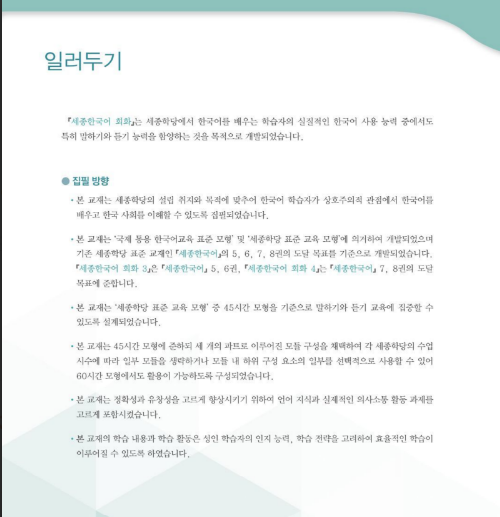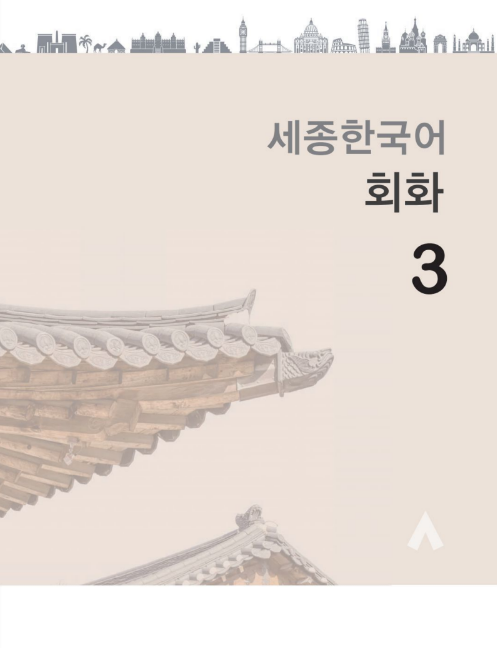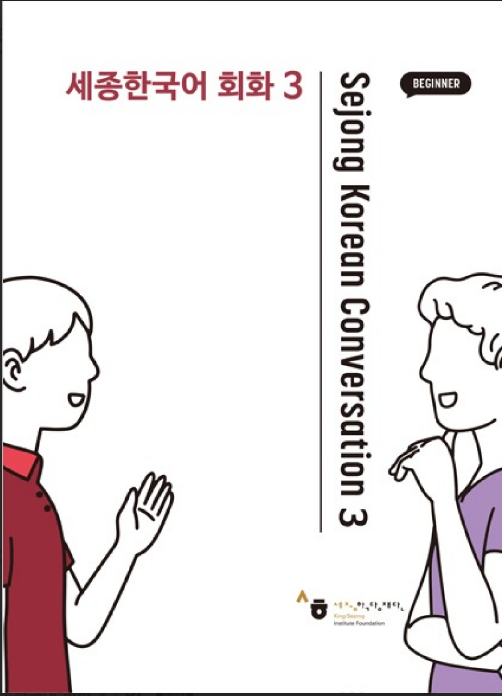


일러두기
『세종한국어 회화』는 세종학당에서 한국어 표준 교수·학습 모형의 실질적인 한국어 사용 능력 중에서도 특히 말하기와 듣기 능력 함양을 목적으로 개발되었습니다.
● 집필 방향
- 본 교재는 세종학당의 설립 취지와 목적에 맞추어 한국어 학습자가 상호주의적 관점에서 한국어를 배우고 한국 사회를 이해할 수 있도록 집필되었습니다.
- 본 교재는 ‘국제 통용 한국어 표준 모형’ 및 ‘세종학당 표준 모형’에 의거하여 개발되었으며 기존 세종한국어 표준 교재인 『세종한국어』의 5, 6, 7, 8권의 도달 목표를 기준으로 개발되었습니다. 『세종한국어 회화』 3A은 『세종한국어』 5, 6권, 『세종한국어 회화』 4A은 『세종한국어』 7, 8권의 도달 목표에 준합니다.
- 본 교재는 ‘세종학당 표준 모형’ 중 45시간 모형을 기준으로 말하기와 듣기 교육에 집중할 수 있도록 설계되었습니다.
- 본 교재는 45시간 모형에 준하되 제 개의 파트로 이루어진 모듈 구성을 채택하여 각 세종학당의 수업 시수에 따라 일부 모듈을 생략하거나 모듈 내 하위 구성 요소를 선택적으로 사용할 수 있어 60시간 모형에서도 활용이 가능하도록 구성되었습니다.
- 본 교재는 정확성과 유창성을 고르게 향상시키기 위하여 언어 지식과 실제적인 의사소통 활동 과제를 고르게 포함시켰습니다.
- 본 교재의 학슴 내용과 학습 활동은 성인 학습자의 인지 능력, 학습 전략을 고려하여 효율적인 학습이 이루어질 수 있도록 하였습니다.
Introductory Remarks
“Sejong Korean Conversation” is a series developed for Korean language learners studying at the King Sejong Institute with aims to develop practical Korean language skills, especially speaking and listening skills.
● Approaches
- The purpose of this textbook is to help Korean language learners understand Korean language and Korean society from an intercultural perspective, which is in accordance with the aims and purpose of the King Sejong Institute.
- The following textbook is developed based on the “International Standard Model
Cột Trái:
- • Part 2′ 의 ‘표현’ 에서는 단원 주제에
맞는 단어 합성에 필수적인 표현을 제
시하였습니다.
The ‘Expression’ component in ‘Part 2’
provides essential expression components
in accordance with each unit’s topic and
dialogue. - • 주어진 정보 를 이용하여 대화 를 완성
하는 ‘말하기’ 활동 을 하도록 구성하였
습니다. 그리고 이를 통하여 배운 표현
을 연습하고 학습한 표현의 기능 을 확
인할 수 있도록 하였습니다.
Students are able to practice the learned
expressions and conversation through
the ‘speaking’ activity which requires
completing the conversation with the
given information. - • 유의미한 의시소통 활동 을 통하여 실
제적인 맥락 속 에서 배운 표현을 즉시
사용해 볼 수 있도록 하였습니다.
Meaningful activities enable the learner
to make immediate use of the vocabulary
learned from the context.
Cột Phải (Trang Sách Giáo Khoa):
Part 2
(Không có tiêu đề rõ ràng cho Phần 2 trong phần này)
1. 문화와 사람들을 소개하는 표현
- 다음과 같이 빈칸에 알맞은 표현을 넣어 대화를 완성해 봅시다.
A: Can you introduce yourself?
B: Yes, I can.
A: What is your name?
B: My name is Maria.
A: Where are you from?
B: I’m from Mexico.
A: What do you do?
B: I’m a student.
2. 두 사람이 나눈 대화의 내용을 떠올리며 다음을 완성해 봅시다.
1. 이름
A: What’s your name?
B: Maria
2. 출신 국가
A: Where are you from?
B: Mexico
3. 직업
A: What do you do?
B: I’m a student.
3. 다음 대화를 듣고 빈칸에 알맞은 표현을 넣어 봅시다.
(Biểu tượng audio)
A: What do you do?
B: I’m a photographer.
A: Oh, really?
B: Yes.
4. 다음은 어떤 상황을 묘사한 것인지 골라 봅시다.
[Hình ảnh: Một người đang chụp ảnh]
1. A doctor talking to a patient.
2. A student giving a presentation.
3. A photographer taking pictures.
5. 빈칸에 알맞은 표현을 넣어 다음 대화를 완성해 봅시다.
A: What do you do?
B: I’m a teacher.
A: That sounds interesting.
B: Yes, I really like it.
Part 3
1. 이야기 해 봐요 (Let’s Talk)
1. 다음을 보고 두 사람이 나눈 대화의 내용을 확인해 봅시다.
* What is the man’s job?
1. A pilot
2. A musician
3. A chef
* What is the woman’s job?
1. A dancer
2. A painter
3. A writer
* What do they like to do?
1. Both enjoy their jobs.
2. The man likes to cook, and the woman likes to paint.
3. They both want to change jobs.
2. 다음은 어떤 사람들이 나와 있는지, 무슨 일을 하는지 이야기해 봅시다.
[Hình ảnh: Một đầu bếp nam]
Chef
* Loves cooking
* Enjoys creating new dishes code Codedownloadcontent_copyexpand_less
[Hình ảnh: Một họa sĩ nữ]
**Painter**
* Enjoys painting
* Expresses emotions through art
3. 목표 담화와 유사한 주제로 다음 질문에 답해 봅시다.
1. What is your dream job? Why?
2. What do you like to do in your free time?
3. Do you think it’s important to enjoy your job? Why?
4. 다음 활동을 통하여 목표 담화의 내용을 파악하고, 실제 자신의 이야기로 구성해 봅시다.
* 나의 직업 (My Job)
– 꿈꾸는 직업 (Dream Job): __________
– 직업을 선택한 이유 (Reason for choosing the job): __________
* 나의 취미 (My Hobby)
– 취미 (Hobby): __________
– 취미를 시작하게 된 계기 (Reason for starting the hobby): __________
* 나의 관심사 (My Interest)
– 관심 있는 분야 (Field of interest): __________
– 관심 있는 이유 (Reason for interest): __________
Cột Trái (Trang Sách Giáo Khoa):
Part 3
2. 듣고 말해요 (Listen & Speak)
1. 다음을 듣고 주인공의 직업과 관련된 내용을 모두 골라 봅시다.
(Biểu tượng audio)
1. He is a musician.
2. He plays the guitar.
3. He likes to practice every day.
4. He enjoys performing for others.
5. He wants to be a famous singer.
2. 다음은 무엇에 대한 이야기인가요? 어떤 활동을 하는지 이야기해 봅시다.
[Hình ảnh: Mọi người chơi nhạc cụ và hát]
* 직업 (Job): Musician
* 활동 (Activities):
– Playing musical instruments
– Singing
– Practicing
– Performing
3. 다음 대화를 듣고 빈칸에 알맞은 표현을 넣어 봅시다.
(Biểu tượng audio)
A: What do you do?
B: I’m a musician.
A: Wow! That’s cool. Do you play any instruments?
B: Yes, I play the guitar.
A: Do you enjoy performing?
B: Yes, I really enjoy performing for others.
4. 대화 내용을 떠올리며 다음 질문에 답해 봅시다.
1. What is the man’s job?
He is a musician.
2. What instrument does he play?
He plays the guitar.
3. Does he enjoy performing?
Yes, he enjoys performing for others.
Cột Phải (Các Khung Văn Bản):
- • Part 3′ 의 ‘이야기 해 봐요’ 에서는 학습
한 어휘 와 표현을 활용한 목표 담화 를
제시하였습니다.
The ‘Let’s Talk’ component from ‘Part 3’
provides dialogue that makes use of the
target vocabulary and expression. - • 목표 담화 의 내용 을 확인하고 이야기
해 볼 수 있는 활동 을 제시하였습니다.
The activities provide a chance to review
the target dialogue and contents. - • 목표 담화 와 유사한 주제 의 담화 를
자신 의 정보 를 이용하여 구성할 수
있도록 의미 있는 활동 을 제시 하였습
니다.
Meaningful activities present conversations
that are similar to the topic of the target
discourse.
Cột Trái (Các Khung Văn Bản):
- • Part 3′ 의 ‘듣고 말해요’ 에서는 주제에
관련된 보다 실제적인 담화 를 이해하
고 생산할 수 있는 활동 을 제시하였습
니다.
The ‘Let’s Listen and Speak’ component
from ‘Part 3’ provides activities to
understand and produce dialogue related
to the topic. - • 듣기 내용 과 연계 하여 목표 담화 의
주제 에 맞는 말하기 과제 를 제시 하였
습니다.
In connection with the Listening contents,
speaking tasks that meet the topic and
target discourse are presented.
Cột Phải (Trang Sách Giáo Khoa):
Part 3
3. 더 말해 봐요 (Let’s Talk More)
1. 다음은 어떤 상황을 묘사한 것인지, 어떤 대화를 나눌 수 있는지 생각해 봅시다.
[Hình ảnh: Bác sĩ, Lập trình viên, Đầu bếp, Nghệ sĩ]
1. 의사 (Doctor)
– 환자에게 증상을 묻고 진찰한다. (Asks about symptoms and examines the patient.)
– 친절하게 설명하고 치료 방법을 안내한다. (Explains kindly and guides treatment methods.)
2. 프로그래머 (Programmer)
– 새로운 프로그램을 개발하고 코딩한다. (Develops new programs and codes.)
– 오류를 수정하고 프로그램을 개선한다. (Fixes errors and improves programs.)
3. 요리사 (Chef)
– 새로운 요리를 개발하고 재료를 준비한다. (Develops new dishes and prepares ingredients.)
– 요리를 완성하고 손님에게 제공한다. (Completes cooking and serves it to customers.)
4. 예술가 (Artist)
– 자신의 생각을 작품으로 표현한다. (Expresses one’s thoughts through artwork.)
– 작품 전시회에 참가하여 작품을 소개한다. (Participates in exhibitions and introduces artworks.)
2. 빈칸에 알맞은 표현을 넣어 다음 대화와 같은 상황을 만들어 봅시다.
* 상황 1 (Situation 1)
A: Excuse me, Doctor. I have a sore throat.
B: Let me see. Hmm, it seems like a cold. I’ll prescribe some medicine.
* 상황 2 (Situation 2)
A: Can you help me with this program? I’m getting an error.
B: Let me check. It seems there’s a bug in the code. I’ll fix it for you.
3. 다음 질문에 답해 봅시다.
1. What is your dream job?
2. What are the main tasks of that job?
3. What skills are needed for that job?
4. 다음은 어떤 직업인지, 무슨 일을 하는지 생각해 봅시다.
* 직업 (Job): _________
* 하는 일 (Tasks): _________
* 필요한 능력 (Required Skills): _________
Cột Trái (Các Khung Văn Bản):
- • Part 3′ 의 ‘더 말해 봐요’ 에서는 해당
단원 운영, 어휘, 내용을 총체적
으로 이용할 수 있는 활동 을 제시 하였
습니다.
‘Let’s Talk More’ in ‘Part 3’ presents
activities which make use of sentence
structures, vocabulary and content in the
unit. - • 학습한 주제 네에서 실제 발화 와 유사
한 상황 과 맥락 을 제시 하여 학습자
들이 실 제적 이고 유의미한 활동 을 할 수
있게 하였습니다.
Contexts and situations that are similar
to the actual context allow learners to
do practical and meaningful activities. - • 대화 통제 를 최소화 하여 학습자 들이
자유롭게 말할 수 있는 기회 를 제공 하였
습니다.
By minimizing intervention, students are
provided more opportunity to speak freely.
Cột Phải (Trang Sách Giáo Khoa):
Part 3
4. 더 말해 봐요 (Let’s Talk More)
1. 다음은 어떤 상황을 묘사한 것인지, 어떤 대화를 나눌 수 있는지 생각해 봅시다.
[Hình ảnh: Bác sĩ, Lập trình viên, Đầu bếp, Nghệ sĩ]
1. 의사 (Doctor)
– 환자에게 증상을 묻고 진찰한다. (Asks about symptoms and examines the patient.)
– 친절하게 설명하고 치료 방법을 안내한다. (Explains kindly and guides treatment methods.)
2. 프로그래머 (Programmer)
– 새로운 프로그램을 개발하고 코딩한다. (Develops new programs and codes.)
– 오류를 수정하고 프로그램을 개선한다. (Fixes errors and improves programs.)
3. 요리사 (Chef)
– 새로운 요리를 개발하고 재료를 준비한다. (Develops new dishes and prepares ingredients.)
– 요리를 완성하고 손님에게 제공한다. (Completes cooking and serves it to customers.)
4. 예술가 (Artist)
– 자신의 생각을 작품으로 표현한다. (Expresses one’s thoughts through artwork.)
– 작품 전시회에 참가하여 작품을 소개한다. (Participates in exhibitions and introduces artworks.)
2. 빈칸에 알맞은 표현을 넣어 다음 대화와 같은 상황을 만들어 봅시다.
* 상황 1 (Situation 1)
A: Excuse me, Doctor. I have a sore throat.
B: Let me see. Hmm, it seems like a cold. I’ll prescribe some medicine.
* 상황 2 (Situation 2)
A: Can you help me with this program? I’m getting an error.
B: Let me check. It seems there’s a bug in the code. I’ll fix it for you.
3. 다음 질문에 답해 봅시다.
1. What is your dream job?
2. What are the main tasks of that job?
3. What skills are needed for that job?
4. 다음은 어떤 직업인지, 무슨 일을 하는지 생각해 봅시다.
* 직업 (Job): _________
* 하는 일 (Tasks): _________
* 필요한 능력 (Required Skills): _________


